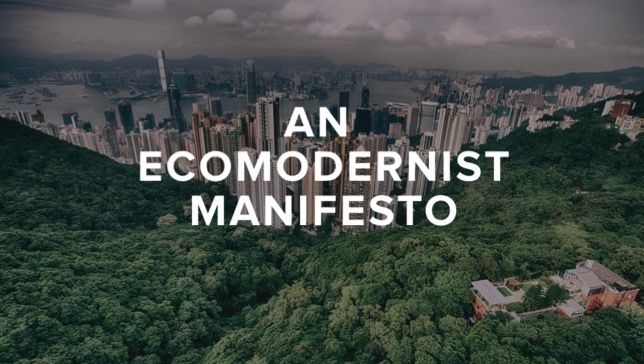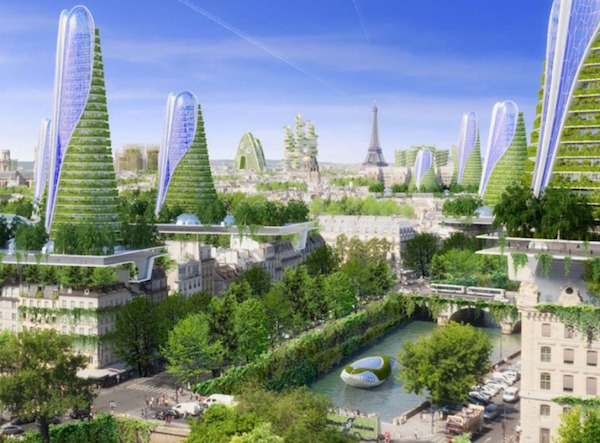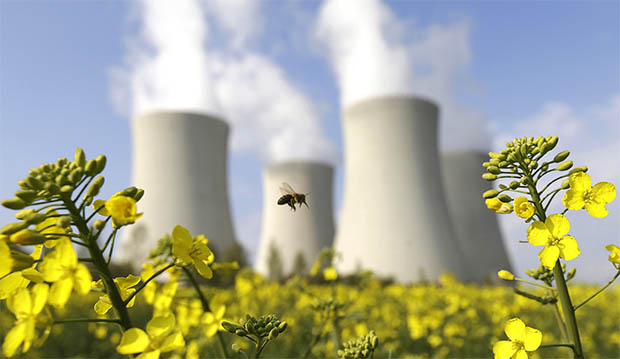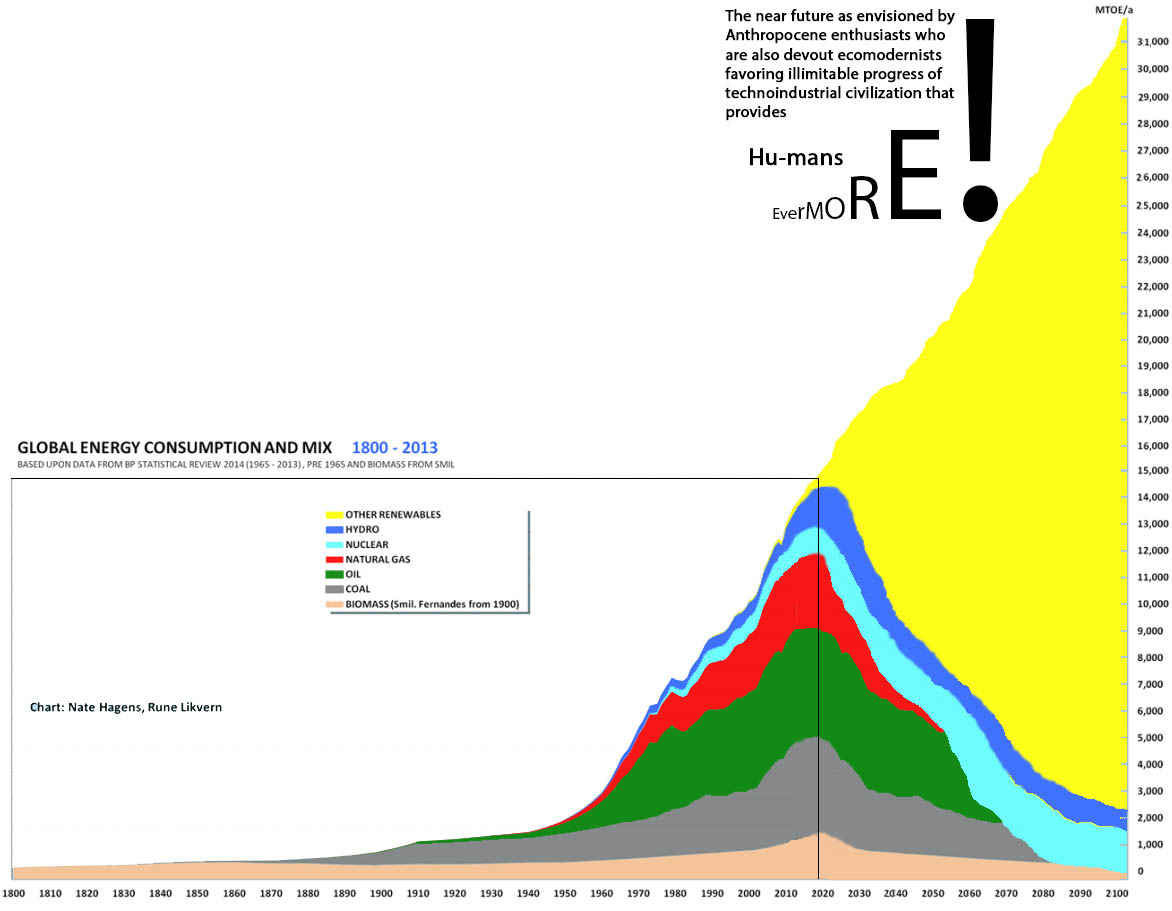
WEDNESDAY, JUNE 7, 2017: NOTE TO FILE

Ecomodernist Manifesto
Boiled Down
Charles Dawkins, Professor Emeritus, Sustainability Science, Kundop University
TOPICS: FOR A GOOD ANTHROPOCENE NOW, FROM THE WIRES, WHY WAIT?
Abstract: Professor Dawkins educates me. The only distinction I can claim is that not only could I be wrong about everything, but I admit that I am.
TUCSON (A-P) — [A note from Eric Lee: As I admit, I could be wrong about everything. Finally someone who knows more than I do has offered to educate me. My gratitude is exceeded only by my willingness to share, so please do read attentively. Professor Dawkins referred to me by name in his article, and as I frequently google my name, his article became known to me. He apparently didn't think that I would receive criticism as the highest service another could bestow upon me, and so didn't send me a copy.]
Let It Be Known
 If you have existential concerns about humanity's future, just look at the past. It will be more of the same, which is to say more and better. It's called evolution. The nineteen scientists, scholars and academics who wrote An Ecomodernist Manifesto know enough to have an opinion, and uncounted more of our best educated and brightest agree with them. Listen to them even if you don't have time to read all their books. They wish us all to have a good Anthropocene because we can, so don't listen to nay-saying eco-fascists. The majority of scientists, scholars and academics know more than the 99.9% and are smarter, or at least less delusional, than any Anthropocene non-enthusiast (e.g. Ted Kaczynski, Eric Lee) you can name.
If you have existential concerns about humanity's future, just look at the past. It will be more of the same, which is to say more and better. It's called evolution. The nineteen scientists, scholars and academics who wrote An Ecomodernist Manifesto know enough to have an opinion, and uncounted more of our best educated and brightest agree with them. Listen to them even if you don't have time to read all their books. They wish us all to have a good Anthropocene because we can, so don't listen to nay-saying eco-fascists. The majority of scientists, scholars and academics know more than the 99.9% and are smarter, or at least less delusional, than any Anthropocene non-enthusiast (e.g. Ted Kaczynski, Eric Lee) you can name.
Despite frequent assertions starting in the 1970s of fundamental “limits to growth,” there is still remarkably little evidence that human population and economic expansion will outstrip the capacity to grow food or procure critical material resources in the foreseeable future. To the degree to which there are fixed physical boundaries to human consumption, they are so theoretical as to be functionally irrelevant.
Human civilization can flourish for centuries and millennia on energy delivered from a closed uranium or thorium fuel cycle, or from hydrogen-deuterium fusion. With proper management, humans are at no risk of lacking sufficient agricultural land for food. Given plentiful land and unlimited energy, substitutes for other material inputs to human well-being can easily be found if those inputs become scarce or expensive.
The growth rate of the human population has already peaked. Today’s population growth rate is one percent per year, down from its high point of 2.1 percent in the 1970s. Fertility rates in countries containing more than half of the global population are now below replacement level. Population growth today is primarily driven by longer life spans and lower infant mortality, not by rising fertility rates.
 For the first time in human history, over half the global population lives in cities. By 2050, 70 percent are expected to dwell in cities, a number that could rise to 80 percent or more by the century’s end. Cities are characterized by both dense populations and low fertility rates.
For the first time in human history, over half the global population lives in cities. By 2050, 70 percent are expected to dwell in cities, a number that could rise to 80 percent or more by the century’s end. Cities are characterized by both dense populations and low fertility rates.
Cities occupy just 1 to 3 percent of the Earth’s surface and yet are home to nearly four billion people. As such, cities both drive and symbolize the decoupling of humanity from nature, performing far better than rural economies in providing efficiently for material needs while reducing environmental impacts. As human lives have been liberated from hard agricultural labor, enormous human resources have been freed up for other endeavors. Cities, as people know them today, could not exist without radical changes in farming. In contrast, modernization is not possible in a subsistence agrarian economy.
The average per-capita use of land today is vastly lower than it was 5,000 years ago, despite the fact that modern people enjoy a far richer diet. Thanks to technological improvements in agriculture, during the half-century starting in the mid-1960s, the amount of land required for growing crops and animal feed for the average person declined by one-half.
Agricultural intensification, along with the move away from the use of wood as fuel, has allowed many parts of the world to experience net reforestation. About 80 percent of New England is today forested, compared with about 50 percent at the end of the 19th century. Over the past 20 years, the amount of land dedicated to production forest worldwide declined by 50 million hectares, an area the size of France. The amount of water needed for the average diet has declined by nearly 25 percent over the past half-century. Nitrogen pollution continues to cause eutrophication and large dead zones in places like the Gulf of Mexico. While the total amount of nitrogen pollution is rising, the amount used per unit of production has declined significantly in developed nations. Taken together, these trends mean that the total human impact on the environment, including land-use change, overexploitation, and pollution, can peak and decline this century. By understanding and promoting these emergent processes, humans have the opportunity to re-wild and re-green the Earth — even as developing countries achieve modern living standards, and material poverty ends.
 Consider that a population of no more than one or two million North Americans hunted most of the continent’s large mammals into extinction in the late Pleistocene, while burning and clearing forests across the continent in the process. Extensive human transformations of the environment continued throughout the Holocene period: as much as three-quarters of all deforestation globally occurred before the Industrial Revolution. The technologies that humankind’s ancestors used to meet their needs supported much lower living standards with much higher per-capita impacts on the environment. Absent a massive human die-off, any large-scale attempt at recoupling human societies to nature would result in an unmitigated ecological and human disaster.
Consider that a population of no more than one or two million North Americans hunted most of the continent’s large mammals into extinction in the late Pleistocene, while burning and clearing forests across the continent in the process. Extensive human transformations of the environment continued throughout the Holocene period: as much as three-quarters of all deforestation globally occurred before the Industrial Revolution. The technologies that humankind’s ancestors used to meet their needs supported much lower living standards with much higher per-capita impacts on the environment. Absent a massive human die-off, any large-scale attempt at recoupling human societies to nature would result in an unmitigated ecological and human disaster.
Ecosystems around the world are threatened today because people over-rely on them: people who depend on firewood and charcoal for fuel cut down and degrade forests; people who eat bush meat for food hunt mammal species to local extirpation. Whether it’s a local indigenous community or a foreign corporation that benefits, it is the continued dependence of humans on natural environments that is the problem for the conservation of nature. Conversely, modern technologies, by using natural ecosystem flows and services more efficiently, offer a real chance of reducing the totality of human impacts on the biosphere. To embrace these technologies is to find paths to a good Anthropocene.
Decoupling human well-being from the destruction of nature requires the conscious acceleration of emergent decoupling processes. In some cases, the objective is the development of technological substitutes. Reducing deforestation and indoor air pollution requires the substitution of wood and charcoal with modern energy. In other cases, humanity’s goal should be to use resources more productively. For example, increasing agricultural yields can reduce the conversion of forests and grasslands to farms. Humans should seek to liberate the environment from the economy.
Urbanization, agricultural intensification, nuclear power, aquaculture, and desalination are all processes with a demonstrated potential to reduce human demands on the environment, allowing more room for non-human species. Suburbanization, low-yield farming, and many forms of renewable energy production, in contrast, generally require more land and resources and leave less room for nature.
 Plentiful access to modern energy is an essential prerequisite for human development and for decoupling development from nature. The availability of inexpensive energy allows poor people around the world to stop using forests for fuel. It allows humans to grow more food on less land, thanks to energy-heavy inputs such as fertilizer and tractors. Energy allows humans to recycle waste water and desalinate sea water in order to spare rivers and aquifers. It allows humans to cheaply recycle metal and plastic rather than to mine and refine these minerals. Looking forward, modern energy may allow the capture of carbon from the atmosphere to reduce the accumulated carbon that drives global warming.
Plentiful access to modern energy is an essential prerequisite for human development and for decoupling development from nature. The availability of inexpensive energy allows poor people around the world to stop using forests for fuel. It allows humans to grow more food on less land, thanks to energy-heavy inputs such as fertilizer and tractors. Energy allows humans to recycle waste water and desalinate sea water in order to spare rivers and aquifers. It allows humans to cheaply recycle metal and plastic rather than to mine and refine these minerals. Looking forward, modern energy may allow the capture of carbon from the atmosphere to reduce the accumulated carbon that drives global warming.
In developing countries, rising energy consumption is tightly correlated with rising incomes and improving living standards. Although the use of many other material resource inputs such as nitrogen, timber, and land are beginning to peak, the centrality of energy in human development and its many uses as a substitute for material and human resources suggest that energy consumption will continue to rise through much if not all of the 21st century.
For that reason, any conflict between climate mitigation and the continuing development process through which billions of people around the world are achieving modern living standards will continue to be resolved resoundingly in favor of the latter. Climate change and other global ecological challenges are not the most important immediate concerns for the majority of the world's people. Nor should they be. A new coal-fired power station in Bangladesh may bring air pollution and rising carbon dioxide emissions but will also save lives. For millions living without light and forced to burn dung to cook their food, electricity and modern fuels, no matter the source, offer a pathway to a better life, even as they also bring new environmental challenges. Meaningful climate mitigation is fundamentally a technological challenge. Absent profound technological change there is no credible path to meaningful climate mitigation. Transitioning to a world powered by zero-carbon energy sources will require energy technologies that are power dense and capable of scaling to many tens of terawatts to power a growing human economy.
In the long run, next-generation solar, advanced nuclear fission, and nuclear fusion represent the most plausible pathways toward the joint goals of climate stabilization and radical decoupling of humans from nature. During the transition, other energy technologies can provide important social and environmental benefits. Hydroelectric dams, for example, may be a cheap source of low-carbon power for poor nations even though their land and water footprint is relatively large. Fossil fuels with carbon capture and storage can likewise provide substantial environmental benefits over current fossil or biomass energies.
The ethical and pragmatic path toward a just and sustainable global energy economy requires that human beings transition as rapidly as possible to energy sources that are cheap, clean, dense, and abundant. Such a path will require sustained public support for the development and deployment of clean energy technologies, both within nations and between them, through international collaboration and competition, and within a broader framework for global modernization and development.
Modernization has liberated ever more people from lives of poverty and hard agricultural labor, women from chattel status, children and ethnic minorities from oppression, and societies from capricious and arbitrary governance. Greater resource productivity associated with modern socio-technological systems has allowed human societies to meet human needs with fewer resource inputs and less impact on the environment. More-productive economies are wealthier economies, capable of better meeting human needs while committing more of their economic surplus to non-economic amenities, including better human health, greater human freedom and opportunity, arts, culture, and the conservation of nature.
 Modernizing processes are far from complete, even in advanced developed economies. Material consumption has only just begun to peak in the wealthiest societies. Decoupling of human welfare from environmental impacts will require a sustained commitment to technological progress and the continuing evolution of social, economic, and political institutions alongside those changes. Accelerated technological progress will require the active, assertive, and aggressive participation of private sector entrepreneurs, markets, civil society, and the state. While we reject the planning fallacy of the 1950s, we continue to embrace a strong public role in addressing environmental problems and accelerating technological innovation, including research to develop better technologies, subsidies, and other measures to help bring them to market, and regulations to mitigate environmental hazards. And international collaboration on technological innovation and technology transfer is essential in the areas of agriculture and energy.
Modernizing processes are far from complete, even in advanced developed economies. Material consumption has only just begun to peak in the wealthiest societies. Decoupling of human welfare from environmental impacts will require a sustained commitment to technological progress and the continuing evolution of social, economic, and political institutions alongside those changes. Accelerated technological progress will require the active, assertive, and aggressive participation of private sector entrepreneurs, markets, civil society, and the state. While we reject the planning fallacy of the 1950s, we continue to embrace a strong public role in addressing environmental problems and accelerating technological innovation, including research to develop better technologies, subsidies, and other measures to help bring them to market, and regulations to mitigate environmental hazards. And international collaboration on technological innovation and technology transfer is essential in the areas of agriculture and energy.
Except for the first paragraph, all the above quoted from the Ecomodernist Manifesto. You can believe what you want to believe and who to believe. So why believe stupid shit from a know-nothing who just doesn't get it when you can believe what Anthropocene enthusiasts, the 99+% of those living in industrial society, deeply believe. It is my hope that this article might contribute to an improvement in the quality and tenor of the dialogue about how to protect the environment in the 21st century. Too often discussions about the environment have been dominated by extremists like Lee, and plagued by dogmatism, which in turn fuels intolerance. Unlike some extremists, I value the liberal principles of democracy, tolerance, and pluralism in themselves, even as I affirm them as keys to achieving a great Anthropocene. I hope that any misguided and misinformed readers wake up and endeavor to achieve universal human dignity on a biodiverse and thriving planet. Read the Ecomoderist Manifesto and seek ecologically informed sources.

Note: As described in the PNAS we can transition to all renewable energy sources by 2050 to 2055. Some insist nuclear is needed and fossil fuels, whose CO2 emissions are sequestered, will be needed for a time. Up to 2017, no alternative energy sources were developed. The Wood Age was replaced by the Coal Age to fuel industrial development, but consumption of biomass continued to increase as coal merely added to the energy mix that fueled growth. To be alternative, use of wood/biomass would have ended as coal would have replaced wood if it were 'alternative' in the ecomodern meaning of the word. Oil and gas became preferred for use in the more industrialize wealthy areas as its combustion products were less visible and emergy yield higher. Oil and gas use added to, did not replace, coal use which continued to increase. Fossil fuels allowed the development of hydroelectric and nuclear power. Solar PV and wind generators were also made by fossil fuels, especially by dirty coal in China, but concerns about global warming being human caused has a simple fix. All carbon produced by the combustion of fossil fuels will be captured and alternative power sources developed as doing so is merely a matter of deciding to do so. There really are no biophysical limits to clever-ape solutions. We'll continue to grow the economy so the world's poor can get richer, using alternative energy sources too numerous to list which, unlike all prior so-called alternatives, will replace all other sources including nuclear even though by 2100 it will be safe and too cheap to meter. Hydroelectric dams may last only 400 years or so on average, so as alternative wind and solar become too cheap to meter, they can be phased out and rivers restored to full natural flow. Wood may still be used as fuel, but only for recreational use in home fireplaces or campfires. By 2100, population will naturally decrease so per capita consumption will continue to increase as the poor continue, evermore equitably, to get richer.
 Meanwhile, 'the pace of planetary destruction has not slowed'. But what? Me worry?
Meanwhile, 'the pace of planetary destruction has not slowed'. But what? Me worry?
To understand cornucopianism, know that what "most of these doomsday scenarios have gotten wrong is the fundamental idea of [NC, neoclassical] economics: people respond to incentives. If the price of a good goes up, people demand less of it, the companies that make it figure out how to make more of it, and everyone tries to figure out how to produce substitutes for it. Add to that the march of technological innovation (like the green revolution, birth control, computers, robotics, gene control, nanotech, etc.). The end result: markets figure out how to deal with problems of supply and demand." —Steven Levitt, Freakonomics, University of Chicago where Milton Friedman memes are still alive and replicating. At the time, Levitt admitted freely that he knew next to nothing about oil but that that was not an impediment to understanding peak oil problems. Humans are clever apes and if they want more oil they'll find it or come up with a substitute. Anthropocene enthusiasts know he knows that what he is saying is indubitably RIGHT! Doomers want you to consider the possibility that Professor Levitt is getting his scenarios wrong, skewed towards the up and up forever narrative of NCE.
Cornucopian thought boils down to this: the future will continue the trends of the past. Everyone knows that we are unique, that the ever accelerating world of change will remake itself in our lifetimes. We are the special generation who will see, for the first time in millennia, that the future will continue the trends of the past.
To understand growth, think of "long-term growth as a sequence of exponential modes," which means that if you take the REALLY long view, human history can be modeled as a series of exponential curves. Each one has a certain lifetime before it is overtaken by an even faster exponential curve. Human history is a graphic example of exponentially increasing progress onward to our inevitable Singularity.
And what happens when you extrapolate this forward? The prediction is clear: within the next few decades, economic growth will switch to a new exponential mode, far faster than anything we have seen before. The economy will begin accelerating, doubling in size in a period of weeks rather than a decade (China) or three (USA) as today. We will see more change and growth in a year than we have seen throughout all of human history.
It may seem inconceivable that any technology or advancement could support such rapid growth, but actually there are an ever increasing number of technologies that will do so. Computer technology already has a doubling time of one to two years, far faster than the economy as a whole. Pervasive computing, artificial intelligence, and new technologies like nanotech will transform every aspect of society as other technologies have (e.g. cars). One would only have to ask for something and an AI could design it, then a nanotech factory could build it on the spot while you sip your latte. In such a world, the kinds of limitations we are familiar with, or that doomers claim exist, will be a thing of the past.
And clearly, energy will not be a limiting factor. We are surrounded by energy, vast quantities of it. Enough solar energy falls on the earth to let us vastly expand our per-capita usage levels. Fusion energy from sea water and cheap elements is another inexhaustible source. Solar system resources will clearly become available as well and then there is a galaxy for the taking.
We only lack the intelligence to know how to access this energy. Once intelligence becomes a commodity to be created at will using AI, once tools exist to allow us to structure matter however we desire at the molecular level, all sources of energy will become available and all things imaginable become possible. In the long run, energy and matter are effectively unlimited.
Most academics may be "inecoalate" in the questionable judgement of a few, possibly senile, professors. Most professors who are human, e.g. humanists, know that we must view the future with optimism and believe that humans are clever beyond belief. They want you to have a good Anthropocene, no doubt about it. Steven Pinker is an optimist who sees only practical solutions in our future. Read his Enlightenment Now book ("My new favorite book of all time." —Bill Gates), or just the abstracts of what Anthropocene enthusiasts like Pinker talk about at conferences where nay-saying doomers fear to tread. Anthropocene enthusiasts got what denizens of technoindustrial society want.
The ecomoderist vision of the future may sound like science fiction, but the point is that it would actually be remarkable if something like this DOESN'T happen because exactly this sort of revolutionary growth transition has been the pattern of human history as we passed from fruit sucking apes to mighty hunters, prosperous farmers, and on to industrialized transhuman giants. Only if we assume that modern times are different and that there has been a new and unprecedented change in the factors which have controlled and guided human progress, can we get off this path that leads to a vastly more powerful and capable future world. We are hu-mans, hubris Man, and our hubris is justified. I love the smell of hubris in the morning.

Early Anthopocene enthusiast: "One would like to see mankind spend the balance of the century in a total effort to clean up and groom the surface of the globe — wipe out the jungles, turn deserts and swamps into arable land, terrace barren mountains, regulate rivers, eradicate all pests, control the weather, and make the whole land mass a fit habitation for Man. The globe should be our and not nature's home, and we no longer nature's guests." —Eric Hoffer 1967 [I was reading a hundred or so of his quotes, then this one came up.]
SUBNOTE TO FILE 4/23/22:
It turns out that more (bigger) really is better. Vox-co-founder (and the guy who coined the expression "The Great Awokening") tells all. Mathew Yglesias' 2020 book is called: One Billion Americans: The Case for Thinking Bigger. Don't listen to doomers who foolishly believe in limits to growth for some anti-human ecofascist pretend reason. Read Vox ('Millions turn to Vox to understand what’s happening in the news.') or the Atlantic Monthly (e.g. 'Why the U.S. Population is Collapsing'', enquiring minds want to know) to get the straight dope. For example read, 'The case for more — many more — Americans''. If one billion Americans (1/3 of a billion Americans are consuming 1/4 of the planet's—actually humanity's—resources) are good, then 3 billion will be better, will help grow the economy and maximize gender diversity. The United States population grew by "ONLY" 22 million between the 2010 and 2020 Censuses. More Americans will certainly live more interesting lives in freedom and democracy for all when the brutal ethnic repression ends, when America is finally fully Woke when the New Cultural Revolution is visited upon all.
And further North, adding an extra 65 Million people living in Canada’s cities by 2100 will increase Canada's ecological assets. Underpopulation harms Canada’s climate and ecological prospects, forcing Canadians to use energy-inefficient and polluting transportation systems and heating technologies. And underpopulation prevents humanity from replacing inefficient systems and technologies with green energy that would protect all of us against the effects of climate change. More people are needed to press for ecological protection. Read the 247 page book: Maximum Canada: Why 35 Million Canadians Are Not Enough and work to minimize ecological fascism. If more is better for rich countries, then obviously it will be more better for poor and brutally repressed countries yearning to grow their economies to end poverty.
